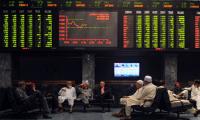KARACHI: Pakistan’s current account balance swung back to a surplus in November, ending a four-month streak of deficits, as the primary income and trade in services improved, the central bank data showed on Monday.
The current account, which measures the flow of goods, services and investments into and out of the country, showed a surplus of $9 million in November, compared with a deficit of $184 million in October and $157 million a year earlier, the State Bank of Pakistan (SBP) said.
It was the first surplus since June 2023, when the current account recorded a surplus of $334 million. The current account had been in surplus for four consecutive months from March to June, before slipping into deficit from July to October.
November saw an uptick in imports and remittances, and a flattening of exports; nonetheless, the primary income increased and contributed to the current account's return to positive territory.
“Primary Income deficit improved by 42 percent month-on-month to $509 million in November on higher base effect, likely due to adjustments related to profit repatriations and higher debt repayment in October,” said Maaz Azam, an analyst at Optimus Capital Management.
The current account balance was also aided by the 20 percent decrease in trade in services deficit in November over the previous month, he added.
Balance of trade in services clocked in at $199 million in November, compared with $250 million in October.
In a note, Topline Securities said that the SBP reported a trade deficit of $1.7 billion for November, whereas the Pakistan Bureau of Statistics (PBS) reported a $1.9 billion goods trade deficit.
When it comes to exports, PBS claimed $2.57 billion in exports in November, whereas the SBP reported $2.73 billion, up 22 percent from the last year but down 1 percent from the previous month. This is where the reported numbers diverge the most, it said.
Conversely, imports reached $4.5 billion, up 2 percent monthly and 3 percent on an annual basis. “The increase in imports is due to the easing of restrictions at the IMF's demand,” it added.
Remittances from Pakistani citizens working abroad fell to $2.5 billion in November, down 9 percent from the previous month. But compared to the same month last year, remittances rose by 4 percent.
The current account deficit shrank by 64 percent to $1.16 billion in the five months of the current fiscal year. This reduction was facilitated by tighter fiscal and monetary policies, as well as administrative measures taken by the government that resulted in a declining trade balance.
“The government expects the CAD to remain in a range of $4-4.5 billion for FY2024, while the SBP anticipates that the CAD will be 1-1.5 percent of GDP ($3.5-5.5 billion),” said an analyst at Topline Securities.
“However we believe the CAD to remain at around $4 billion in FY2024,” he added. Last week, the SBP maintained its benchmark interest rate at 22 percent, which will assist in decreasing demand, control the fastest-rising inflation in Asia, and strengthen the value of the declining rupee. November saw a 29.23 percent increase in Pakistan's inflation rate, primarily due to rising energy prices. This year, the country's currency fell by around 20 percent compared to the US dollar, and the losses are expected to continue until 2024.
To provide the final approval for a second tranche under Pakistan's $3 billion loan programme, the IMF executive board will meet on January 11.
The SBP's monetary policy statement, last week, stated that although the foreign exchange reserves have been gradually declining due to continued debt repayments and weak official inflows since July, financial inflows would resume if the IMF's first review is completed satisfactorily.
The money from the global lender will increase foreign exchange reserves—which are currently insufficient to cover less thantwo months' worth of imports—and support the still-fragile economy. The SBP’s governor Jameel Ahmad told analysts last week that the external debt repayments are expected to remain on track.
The governor said the total financing requirement for this fiscal year stands at $24.6 billion, Out of this, principal repayments of more than $4 billion have already been made, which leaves $4 billion in repayments for the remainder year if rollovers are excluded.
The international rating agency Fitch Ratings said in a report that Pakistan's external funding requirements are expected to remain high and its reserves low, leaving it dependent on the IMF and bilateral and multilateral support, which could be jeopardised by policy errors and political volatility, as in the past. Pakistan's rating of "CCC" was affirmed due to some near-term certainty over external liquidity and funding provided by its nine-month stand-by arrangement with the IMF.
“We estimate that Pakistan will meet less than half of its $18 billion funding plan in the first two quarters of the fiscal year ending June 2024 (FY24), excluding routine rollovers of bilateral debt,” it said.
The picture shows a logo of Federation of Pakistan Chambers of Commerce & Industry . — APP/FileKARACHI: Atif Ikram...
The image shows the logo of the Securities and Exchange Commission of Pakistan . — APP/FileISLAMABAD: The Securities...
This image released on January 26, 2023, shows the logo of Archroma. — Facebook/ArchromaKARACHI: Archroma Pakistan...
The logo of the Trade Development Authority of Pakistan . — TDAP website. Mirpur: Kausar Taqadus Gilani, Minister...
This representational image shows Gold bars. — AFP/FileKARACHI: Gold prices in the local market dropped by Rs600 per...
Security personnel walk past the US Federal Reserve building in Washington, DC on Oct 22, 2021. —...







